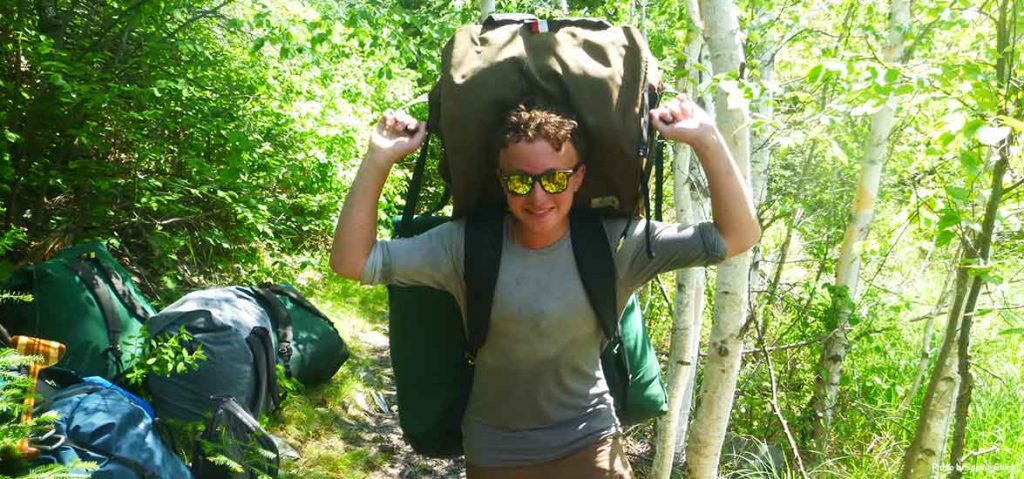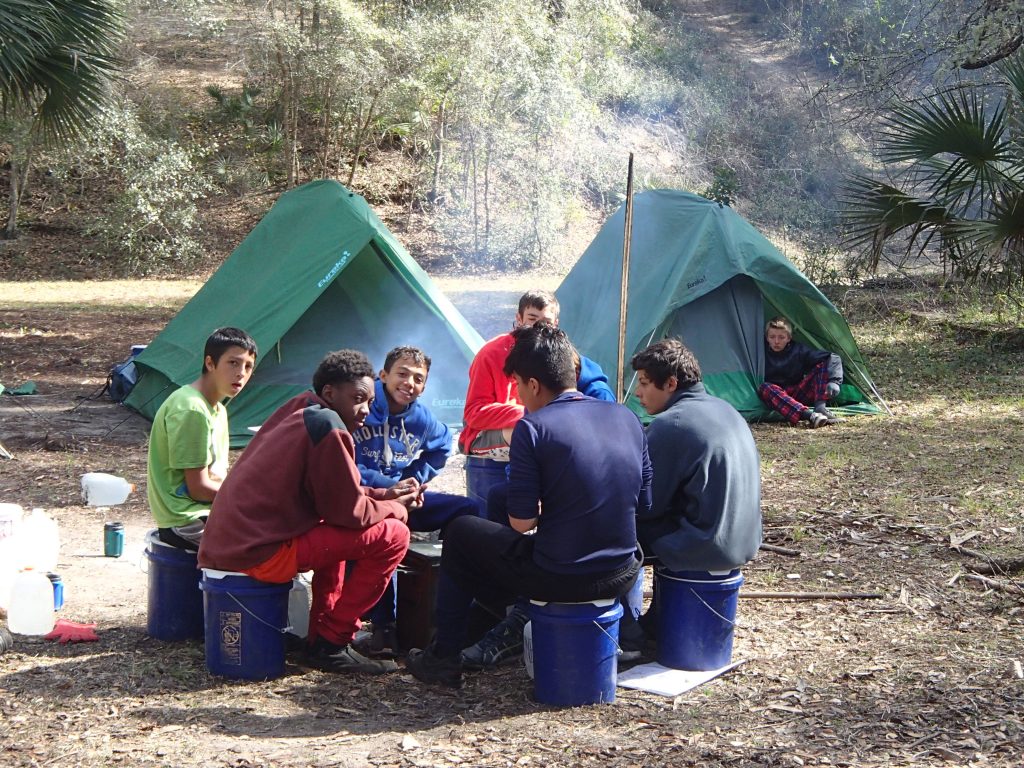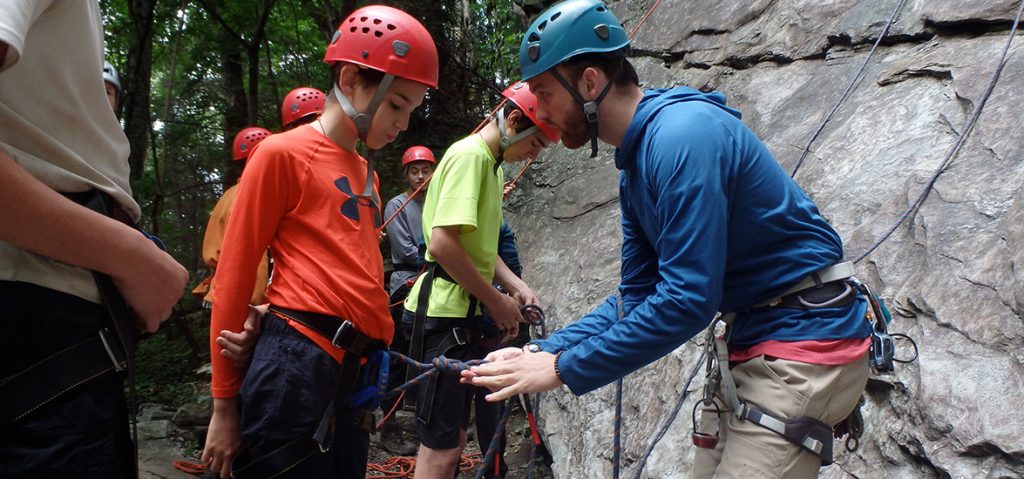The foundation of communicating with struggling teens is the same as you would use with anyone who is struggling: listen, affirm, speak assertively, set clear boundaries, respond honestly and provide support. As with all people, effective communication depends on the individual and what they might need in that moment. It takes time to understand them and know whether they need to be listened to or given direction. Because of that, there is no clear guide on how to communicate effectively in every situation, with every young person. Social backgrounds, immediate context and relationships all take a role in communication, and they influence what is appropriate, inappropriate and helpful in supporting that individual. What I have learned as an Outward Bound Instructor is nuanced and shifting. At times, my tools fail me. At times they bring me great success. But the best tool I have acquired is the ability to reassess and commit myself to learning more.
One of the benefits of instructing for Outward Bound is learning about a diverse range of tools for communication. There are many theories, techniques and tools that serve different situations or relationships. Below I have outlined some of the communication tools that I’ve found to be the most useful. They are all easy to research and may help if you are searching for new resources on communicating with a struggling teen.
Choice Theory
Choice theory is a theory—often practiced in psychology or counseling—that says all humans are fundamentally good, but make choices in order to meet their most basic needs. Those needs include love, power, freedom, fun and survival. As an Instructor, this theory has proven useful in understanding why a student is making a specific choice that may initially be seen as problematic. The choice serves a purpose for that student in that moment. My goal, using choice theory, is to help my students understand the wider range of choices they may have that serve the same need.
For example, on a recent course, one of my students began pretending to be injured on a regular basis. Of course, my initial reaction was to treat the symptoms—however—once it became clear that he was not actually in pain, my mind shifted to choice theory. This student had learned that being injured meant receiving love and belonging. He was choosing to fake injuries because it allowed him to meet his needs. Understanding his mindset allowed my co-Instructors and me to give him clearer and more gratifying opportunities to meet those needs, that weren’t causing him to lose the trust of those around him.

Reality Therapy
Reality Therapy is a tool for engaging in conversation with young people who aren’t getting what they want. In order to have influential conversations, there must always be a level of established trust. From there, Reality Therapy outlines a strategy for remaining present and persistent while poking holes in a student’s logic, to help them question their own choices. On one of my courses I used this tool while talking with a student who had removed herself from the group. She was upset that she had to wash the group pot and was refusing to do so. With Reality Therapy, the conversation often comes back to two themes. The first being, I care about you and I want to help you figure this out. The second being, Is what you’re doing getting you what you want? In other words, “Is talking about not wanting to clean the pot going to make the pot clean?” This may seem harsh, but much of its effectiveness depends on the way you speak and your relationship with the student.
Trauma Informed Care
Trauma Informed Care is a framework for interacting and maintaining a safe space for individuals who have experienced trauma. The basic principles are authenticity, boundaries, consistency and structure. Not all humans react in the same way to the same influences. Trauma Informed Care can help you to better understand trauma responses during communication, and why a young person may be reacting in a way that is difficult to initially understand.
Restorative Practices
Restorative Practices is a theory that encourages giving support, structure and restoration to students who have lost trust. The is useful for community living or for students who aren’t sure how to mend a situation that they have participated in. On day two of a recent course I Instructed, I overheard four of my students discuss plans to sneak out of their tents that night. They were speaking quite openly and, in alignment with Restorative Practices, my co-Instructor and I opened up the conversation to the group. We stated our expectations clearly, saying “We expect you not to sneak out of your tents at night,” followed by why, along with room for questions. The next part of the discussion gave them the space to determine what consequences would be fair should they decide to not follow that expectation. Restorative Practices are not perfect, but in this instance our students were able to understand why we had that rule and design a reasonable outcome should they choose not to follow it.

Triggers and Soothers
Triggers and Soothers describe the daily events that influence us to become emotionally escalated, and what strategies we can use to return to calmness. By better understanding your own triggers and soothers, and those of the young people in your life, it can help better regulate emotions during conversations.
Taking Space
This one may seem simple, but taking space from a conversation is an incredibly useful skill to understand from both sides of a conversation. This concept refers both to when and how to take space, but also when to return to a conversation and finish what you started.
Intent vs. Impact
On a recent canoeing course, one of my co-Instructors asked our students, “Have your parents ever cleaned your room without asking you?” Our group of 12-13 year olds launched into a chorus of “YESSS!” They were infinitely annoyed by this idea. When we asked them why it was so annoying, one student answered, “I can’t find anything in my room, and it makes everything worse.” So while the intent of their parent was to get the room cleaned, the impact was that it made things more confusing for the student. This kind of situation often comes up in difficult conversations, and it takes a great deal of practice to stop and address. Your intent may not be your impact. Listening carefully and taking in feedback goes hand-in-hand with this concept.
Relationship
I often ask my students who the role model is in their lives. Why do they admire them? Somehow, no matter the group, I always get an earnest answer. The truth is, if you are a role model to a young person, they see you. They see what you are doing, how you are doing it and why you are doing it. They see your strength. They also see your flaws—in high definition with 3D glasses on. The most essential tool in effective communication is maintaining the foundation of that relationship. Whether it’s built on trust, love, laughter, forgiveness or any other core value that is important to you, remaining consistent at the core can go far during challenging times.

Don’t Ride the Roller Coaster
In Outdoor Education, we have a saying: “Do not ride the roller coaster.” These words of wisdom have been passed down from generation to generation of Instructors, whispered in unsure ears, written on the insides of wet notebooks and yelled from the tops of icy mountains. At times, they are uttered as a cautionary tale from those of us who have ridden roller coasters. On other occasions they are sung as a beacon of hope from those of us who have learned how to stop. No matter the story behind them, the meaning is essential. Don’t get caught up in the ups and downs.
Our students go through a great deal of challenges on an Outward Bound course. As the Instructors, we are there to support. The same holds true for anyone who is communicating with a struggling teen. Their roller coaster is their rollercoaster, and the better you can see the whole picture, the easier it is to keep them safe while they ride.
Young people are often subject to the expectations, judgements and influence of a society where they have little voice or freedom to navigate independently. They are still in the process of discovering and understanding their own unique challenges, circumstances and identities. Having a person who listens—honestly, reliably and with care, is essential.
About the Author
Rebecca Fenn is an outdoor educator, originally from California, who instructs for NYC Outward Bound Schools and North Carolina Outward Bound School. After graduating from University of Chicago with a major in Human Development, Rebecca worked in college admissions and then began her journey toward outdoor education. She became the Life After Eagle Rock Fellow at Eagle Rock School and Professional Development Center, a wilderness-based boarding school in Estes Park, Colorado. There she taught at-risk students “Math for Life” and served as both a college counselor and as a vocational counselor to prepare them for life after Eagle Rock. Upon receiving a Master’s Degree in Education Policy from Harvard, she decided to delve deeper into the Expeditionary Learning model by taking on the challenge of becoming a Field Instructor for Outward Bound. Rebecca is a cartoonist, artist and writer, and loves the challenges and rewards of working with youth in the outdoors. She is always interested in learning more about educational systems, cultures and practices in the United States.
OTHER POSTS YOU MAY LIKE
Read More
Read More
Read More




